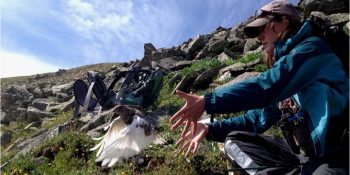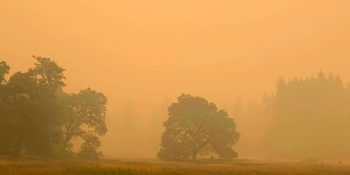MONTROSE, Colo. — Conservation biologists at Colorado Parks and Wildlife are charged with keeping a close eye on sensitive wildlife – animals that sometimes are classified as “species of greatest conservation need” by the agency. One of those species is the Southern White-tailed Ptarmigan.
CPW biologists become alerted when a conservation organization asks the U.S. Fish and Wildlife Service (USFWS) to place an animal on the federal endangered species list. If that animal’s range includes Colorado, a team of CPW biologists put together a plan to study the species to determine how it’s doing here and to present the research to the federal agency for review. The process can take several years.
Recently, a Colorado study of the Southern White-tailed Ptarmigan was used by the USFWS to decide that the iconic bird does not need special protections under the federal Endangered Species Act. The study showed that populations of ptarmigan are holding steady throughout the mountains of Colorado.
“We have widespread distribution of ptarmigan across the state in suitable habitat,” said Amy Seglund, a conservation biologist based in Montrose who coordinated the study. “Not much has changed in their distribution across the alpine ecosystem since they were first studied in the 1960s and 1970s by CPW agency biologists.”
But even with the positive assessment, Seglund said a close eye must be kept on the species because of continuing pressure from climate change and human activity in their alpine habitat.
In 2010, a conservation group sent a petition to the USFWS asking that the bird be added to the endangered species list. To help determine if the request was valid, CPW started initial field work in 2011 to evaluate distribution. More formal population assessment took place from 2013-2017.
The full CPW report on the bird’s status was completed in 2018 and the USFWS issued its “not warranted for listing” conclusion on Dec. 2.
“We follow rigorous scientific protocols in our species conservation assessments” said
David Klute, CPW’s species conservation unit supervisor. “This study took on a
statewide focus and the report was peer reviewed to guarantee its integrity. The ‘not
warranted’ decision by the U.S. Fish and Wildlife Service recognized the thoroughness
of our work and the quality of the information it provided.”
Ptarmigan live year-round from about 9,500 feet elevation and above, so studying these well camouflaged birds is challenging ─ to say the least. Basically, this is how the research method works: Seglund examined previous studies to identify locations the bird occupied. Next, using geographic information, she identified all of the bird’s potential habitat ─ which in Colorado is, essentially, all the millions of acres above timberline.
Using a computer program, 60 sites were selected randomly and field staff went to those locations to look for birds. Some sites were in easy-to-reach alpine basins while others were deep in the wilderness that required field staff to make multiple-day excursions. Each survey location measured 4 kilometers by 5 kilometers.
“Most of the sites required us to navigate steep terrain, it certainly got us in shape,” Seglund said.
At the sites, because the birds are so well camouflaged, the researchers played a recording of male birds and chick calls to help detect the ptarmigan. Seeing birds indicated occupancy. To get more thorough population data, they trapped and placed tiny leg bands on 637 birds. Fortunately, Seglund said, ptarmigan are relatively easy to trap because they stay in place when approached, relying on their camouflage for cover. They also can tolerate being handled by humans.
Leg bands provided researchers an opportunity to evaluate abundance of ptarmigan. The bands also helped Seglund assess whether birds returned to the same breeding sites each year and selected the same mate.
Radio transmitters were placed on 126 birds over the course of the study which allowed field staff to find females later on their nests. There they could see how many eggs the hens had produced, how many hatched and track how many chicks survived. The transmitters also allowed the researchers to determine annual and seasonal survival rates of individuals.
It’s a tough go to make a living above timberline, so not many chicks survive ─ less than one in nests that average 5.46 eggs. They are most often picked off by predators or sometimes killed in big weather events when they are not in close contact with their mothers. At about 10-14 days old the chicks can fly. If they make it to that age they have a good chance of surviving to become an adult bird and begin to breed.
The field work was rigorous and covered not only several years but also required multiple visits to the same site: Each was checked three times over the course of the breeding cycle from nesting to brood-rearing to fledging of the young. Aerial surveys were used during winter to assess survival of radio-collared birds.
Seglund said she is pleased by the study results.
“I was surprised how many birds we found at many of the sites, they’re a very resilient species,” Seglund said.
Yet, despite the solid and widely dispersed populations, Seglund is concerned about the increasing dangers the birds face. One of those is the pressure of human recreation. While they seem to tolerate some human activity, the birds are less capable of handling constant recreational pressure. In the uber-popular Ice Lakes area near Silverton, the ptarmigan disappeared during the course of the study from the narrow alpine meadow through which dozens of hikers pass each day during the warm months.
The other concern: increasing temperatures on the alpine tundra that are accompanying climate change. Ptarmigan are well-known for turning white during the winter and taking shelter beneath the snow. During summer their plumage becomes a mottled brown so they can blend into the landscape. During the warm months they can be found near persistent snowfields foraging and taking snow baths. What they need most during the summer is the moisture and cool temperatures that historically have accompanied the monsoons. But during the last few years the monsoons have been absent, temperatures on the tundra have soared and Seglund worries that the birds are having difficulty handling the heat.
Seglund wrote in the report that CPW and other agencies should develop a long-term program to monitor ptarmigan activity and changes in the alpine environment:
“Agencies must work together to limit disturbances in the alpine and mitigate those that currently exist. Environments are changing with many unknown consequences on the horizon, thus it is imperative for CPW to continue to monitor and work with agencies to manage this iconic alpine species for future generations to enjoy.”
For those reasons, Seglund plans to conduct limited survey work during summers to check on the Ptarmigan.
Seglund is a dedicated scientist who specializes in species that live in the alpine environment. These tundra dwellers hold a special place in her heart.
“It’s amazing to me how a bird that weighs just 350 grams (less than a pound), can live year around at that altitude,” she said. “And they always seem so at peace in their surroundings.”
SPREAD THE NEWS
COMMENT, Like, Follow & SHARE @I70Scout










